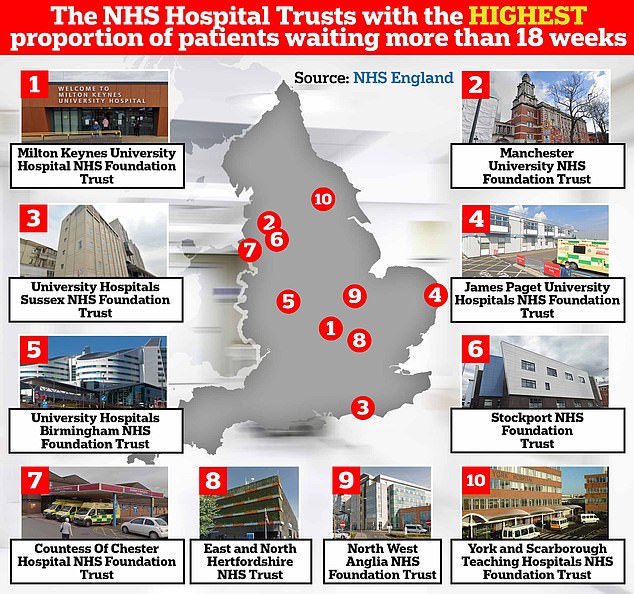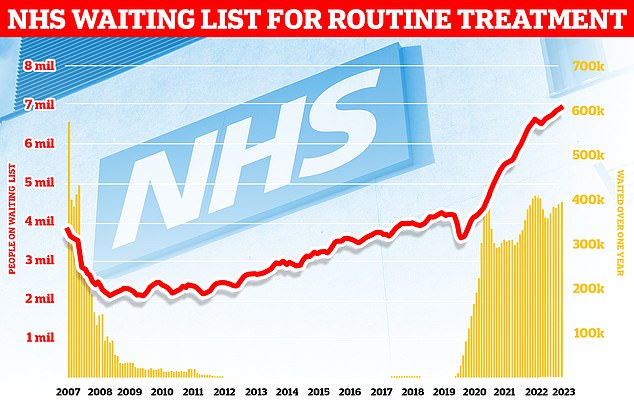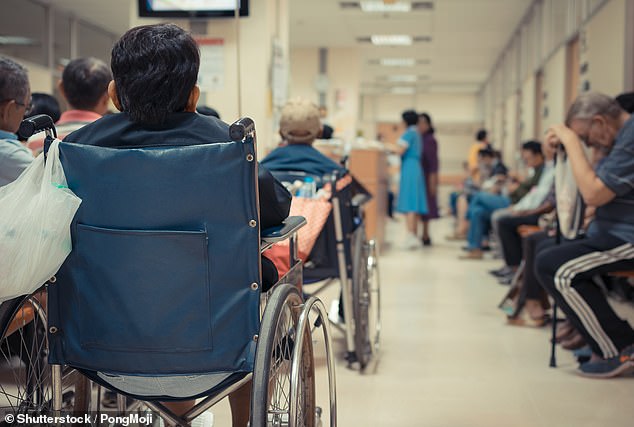Little-known right to help YOU beat NHS waiting lists without having to wait for hospitals to invite you… as data reveals how many patients are waiting at YOUR trust
Patients who have been on the NHS waiting list for at least ten months will be offered treatment hundreds of miles away in a bid to speed up access to care.
Letters, emails and text messages will be sent to around 400,000 patients in England asking if they would be willing to travel to receive treatment faster.
They will be asked how far they are willing to go – 50 miles, 100 miles or nationally – before being matched with alternative hospitals that can see them sooner.
Health leaders insist this move will maximize NHS capacity while offering patients more choice and control.
But critics say it is ‘not a panacea’ and could exclude people who feel too old or sick to travel.
Campaigners also claim that hundreds of thousands of patients who remain on the list should be aware that they have the right to choose where they are treated.
MailOnline’s interactive tool allows you to see the size of the queue at your local hospital and the number of patients who have waited 18 weeks or less – the maximum time patients can wait for treatment under NHS rules.
Users of the MailOnline app can view this by clicking here.

The figures show that Milton Keynes University Hospital NHS Foundation Trust has the highest percentage of patients waiting longer than 18 weeks: 60.6 per cent. Nearly six in ten were also waiting at Manchester University NHS Foundation Trust, which recorded a rate of 57.5 per cent. Around 55.7 per cent had to wait more than 18 weeks at University Hospitals Sussex NHS Foundation Trust, while the figure was 52.8 per cent at James Paget University Hospitals NHS Foundation Trust.
The figures show that Milton Keynes University Hospital NHS Foundation Trust has the highest percentage of patients waiting longer than 18 weeks: 60.6 per cent.
Nearly six in ten were also waiting at Manchester University NHS Foundation Trust, which recorded a rate of 57.5 per cent.
At the other end of the scale, Christie NHS Foundation Trust had just two percent waiting over the timescale – the smallest percentage in the country.
Two other cancer hospitals – Clatterbridge Cancer Center (4.2 per cent) and Royal Marsden NHS Foundation Trusts (5.3 per cent) – were among the other trusts with the smallest shares.
Under new NHS guidelines, patients will be actively asked if they are receiving treatment in alternative hospitals if they are waiting longer than 40 weeks and have no appointment scheduled within the next eight weeks – an estimated 5 percent of registered patients 7.75 million waiting list .
In February 2020, 4.6 million people were waiting for treatment, but the numbers soared when the NHS postponed most routine care during the pandemic to prioritize Covid patients.
The NHS will use a ‘matching platform’ launched earlier this year to match patients with NHS and private sector hospitals outside their region.
If no alternative hospital is found within two months, the patient will remain with their current provider and retain their position on the waiting list.
Despite the pressure to target a portion of patients in the queue, everyone has the right to choose where he or she is referred for a first outpatient appointment.
Under the same rulebook, patients can also transfer to another hospital carrying out NHS procedures with a shorter waiting list if they wait longer than 18 weeks.
But a poll last year found that only half of NHS patients are aware they have the right to choose or change where they receive treatment.
Exactly why the NHS hasn’t done a better job of informing patients about this right is unclear.
While it may have to do with healthcare professionals not knowing that patients have a choice, according to the Patients Association this is seen as more administrative burden for NHS staff or for staff who do not have enough time to discuss the choices with patients.
And if everyone currently waiting for treatment were to transfer to a hospital with a shorter waiting list, it would simply create a longer waiting list at another hospital, the report said.
Amanda Pritchard, CEO of NHS England, said: ‘This new move to offer NHS patients who have waited the longest the option to consider traveling for treatment is just another example of how we are introducing new approaches to reduce patient waiting times, whilst at the same time giving them the choice and improve control they have over their treatment. own care.
‘So whether a patient’s care moves to the next town or somewhere further afield, it is absolutely right that we make the most of available capacity across the country to reduce the backlogs that have inevitably arisen as a result of the pandemic continue to eliminate and provide the best possible service.’

The widening backlog in England stood at 7.75 million in August – the equivalent of one in seven people. This includes nearly 400,000 people stuck in the system for more than a year, often in pain

Patients who have been on the NHS waiting list for at least ten months are being offered treatment hundreds of miles away
Patients will be contacted directly by their NHS trust or independent sector provider.
Health officials said some funding and support will be available to help people who have difficulty traveling, such as taxis or hotels for the elderly or disabled. However, hospitals will decide on a case-by-case basis who has access to these payments.
Louise Ansari, the chief executive of Health Watch England, which represents patients, said: ‘Many patients who face long waits for care will welcome the news that they can now choose to travel for treatment if it means they will be seen sooner .
‘However, without support from the NHS with transport and accommodation costs, this solution will only help those who can afford to travel for faster care.
‘Record numbers of people are currently stuck on NHS waiting lists, and our research has repeatedly highlighted the impact that long waiting times have on patients, particularly people from groups facing health inequalities, including those on lower incomes.
“People have also told us they would welcome the ability to travel to get care faster, as long as any additional costs were covered.”
However, the NHS admits that some patients are not eligible if their clinical condition is too complex, making it inappropriate to travel.
Rory Deighton of the NHS Confederation, which represents healthcare employers, said the move would ease pressure on some of the most stressed parts of the system.
He added: ‘Targeting demand to places with capacity is sensible and will benefit those patients who are able and willing to travel.
‘But health leaders will be aware that this plan will not work for everyone, as some patients will not feel able or comfortable traveling very far for their treatment, and others with minor health conditions may even prefer waiting for an appointment. available from their local healthcare provider.”
Saffron Cordery, deputy chief executive of NHS Providers, said: ‘Giving patients the opportunity to go elsewhere for treatment is not a silver bullet to tackling the causes of the record high numbers of people on NHS waiting lists to take. predict that this could rise to more than eight million by next summer.
‘Long waiting times are a symptom of years of severe workforce shortages and underinvestment in the NHS.’
Health Secretary Steve Barclay said: ‘Empowering people to choose where and when they receive their treatment will help tackle waiting lists and improve access to NHS care.’
